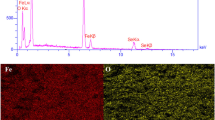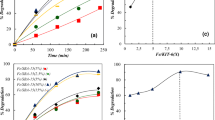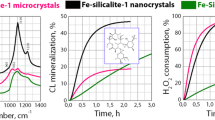Abstract
A novel nanostructured Fenton-like catalyst based on La-doped MgFe2O4 for enhanced carbamazepine degradation was prepared by facile sol-gel synthesis. The physicochemical properties of the obtained catalyst were studied by DTA-TG, XRD, FTIR, SEM-EDX, TEM, and nitrogen adsorption-desorption methods. The effect of calcination temperature on the structure and phase composition of the catalyst was assessed. The influence of the conditions of the catalytic process (dose of catalyst, H2O2 concentration, and pH of model solution) on the efficiency of degradation of an antiepileptic drug, carbamazepine, was scrutinized. The performed studies provided a non-toxic and chemically stable Fenton-like catalyst which demonstrated enhanced efficiency in carbamazepine degradation. The optimal conditions were found as catalyst dose of 0.5 g L−1, H2O2 concentration of 20.0 mmol L−1 and pH of 6.0. The apparent pseudo-first-order rate constant reached up to 0.086 min−1 for MgLa0.1Fe1.9O4 catalyst. Due to its high specific area and enhanced catalytic efficiency, the developed Fenton-like heterogeneous catalyst based on La-doped magnesium ferrite can be used for treating wastewaters polluted with pharmaceutically active compounds.

Graphical abstract
Highlights
-
Fenton-like catalysts based on La-doped magnesium ferrite were obtained.
-
Obtained catalysts were characterized by XRD, BET, SEM, TEM methods.
-
MgLa0.1Fe1.9O4 catalyst demonstrated high catalytic CBZ degradation.












Similar content being viewed by others
References
Patel M, Kumar R, Kishor K et al. (2019) Pharmaceuticals of emerging concern in aquatic systems: chemistry, occurrence, effects, and removal methods. Chem Rev 119(6):3510–3673. https://doi.org/10.1021/acs.chemrev.8b00299
M. Mikulic, Pharmaceutical market: worldwide revenue 2001-2019, Statista (statistics portal for market data, market research and market studies). 2020, https://www.statista.com/statistics/263102/pharmaceutical-market-worldwide-revenue-since-2001/. Data accessed: 04.09.2021.
Fekadu S, Alemayehu E, Dewil R, Van der Bruggen B (2019) Pharmaceuticals in freshwater aquatic environments: A comparison of the African and European challenge. Sci Total Environ 654:324–337. https://doi.org/10.1016/j.scitotenv.2018.11.072
Couto CF, Lange LC, Amaral MCS (2019) Occurrence, fate and removal of pharmaceutically active compounds (PhACs) in water and wastewater treatment plants – A review. J Water Process Eng 32:100927. https://doi.org/10.1016/j.jwpe.2019.100927
Majumder A, Gupta B, Kumar Gupta A (2019) Pharmaceutically active compounds in aqueous environment: A status, toxicity and insights of remediation. Environ Res 176:108542. https://doi.org/10.1016/j.envres.2019.108542
Wang J, Wang SH (2016) Removal of pharmaceuticals and personal care products (PPCPs) from wastewater: A review. J Environ Manag 182:620–640. https://doi.org/10.1016/j.jenvman.2016.07.049
Wang SH, Wang J (2017) Carbamazepine degradation by gamma irradiation coupled to biological treatment. J Hazard Mater 321:639–646. https://doi.org/10.1016/j.jhazmat.2016.09.053
García-Espinoza JD, Mijaylova-Nacheva P, Avilés-Flores M (2018) Electrochemical carbamazepine degradation: Effect of the generated active chlorine, transformation pathways and toxicity. Chemosphere 192:142–151. https://doi.org/10.1016/j.chemosphere.2017.10.147
Guo H, Zhou X, Zhang Y et al. (2020) Carbamazepine degradation by heterogeneous activation of peroxymonosulfate with lanthanum cobaltite perovskite: Performance, mechanism and toxicity. J Environ Sci 91:10–21. https://doi.org/10.1016/j.jes.2020.01.003
Zhang Y, Geissen SU, Gal C (2008) Carbamazepine and diclofenac: removal in wastewater treatment plants and occurrence in water bodies. Chemosphere 73:1151–1161. https://doi.org/10.1016/j.chemosphere.2008.07.086
Mohapatra DP, Brar SK, Tyagi RD et al. (2014) Analysis and advanced oxidation treatment of a persistent pharmaceutical compound in wastewater and wastewater sludge-carbamazepine. Sci Total Environ 470-471:58–75. https://doi.org/10.1016/j.scitotenv.2013.09.034
He Y, Xu J, Zhang Y et al(2012) Oxidative transformation of carbamazepine by manganese oxides. Environ. Sci. Pollut. Res 19 :4206–4213. https://doi.org/10.1007/s11356-012-0949-2
Mohapatra DP, Brar SK, Tyagi RD et al. (2012) Carbamazepine in municipal wastewater and wastewater sludge: ultrafast quantification by laser diode thermal desorption-atmospheric pressure chemical ionization coupled with tandem mass spectrometry. Talanta 99:247–255. https://doi.org/10.1016/j.talanta.2012.05.047
Sillanpää M, Ch. Ncibi M, Matilainen A (2018) Advanced oxidation processes for the removal of natural organic matter from drinking water sources: A comprehensive review. J Environ Manag 208:56–76. https://doi.org/10.1016/j.jenvman.2017.12.009
Kanakaraju D, Glass BD, Oelgemöller M (2018) Advanced oxidation process-mediated removal of pharmaceuticals from water: A review. J Environ Manag 219:189–207. https://doi.org/10.1016/j.jenvman.2018.04.103
Zhu SH, Dong B, Wu Y et al. (2019) Degradation of carbamazepine by vacuum-UV oxidation process: Kinetics modeling and energy efficiency. J Hazard Mater 368:178–185. https://doi.org/10.1016/j.jhazmat.2019.01.043
Zhao CH, Liao ZH, Liu W et al. (2020) Carbon quantum dots modified tubular g-C3N4 with enhanced photocatalytic activity for carbamazepine elimination: Mechanisms, degradation pathway and DFT calculation. J Hazard Mater 381:120957. https://doi.org/10.1016/j.jhazmat.2019.120957
Hübner U, Seiwert B, Reemtsma T et al. (2014) Ozonation products of carbamazepine and their removal from secondary effluents by soil aquifer treatment – Indications from column experiments. Water Res 49:34–43. https://doi.org/10.1016/j.watres.2013.11.016
Wu J, Cagnetta G, Wang B et al. (2019) Efficient degradation of carbamazepine by organo-montmorillonite supported nCoFe2O4-activated peroxymonosulfate process. Chem Eng J 368:824–836. https://doi.org/10.1016/j.cej.2019.02.137
Zhang L, Zhao X, Niu CH et al. (2019) Enhanced activation of peroxymonosulfate by magnetic Co3MnFeO6 nanoparticles for removal of carbamazepine: Efficiency, synergetic mechanism and stability. Chem Eng J 362:851–864. https://doi.org/10.1016/j.cej.2019.01.078
Monsalvo VM, Lopez J, Munoz M et al. (2015) Application of Fenton-like oxidation as pre-treatment for carbamazepine biodegradation. Chem Eng J 264:856–862. https://doi.org/10.1016/j.cej.2014.11.141
Tran N, Drogui P, Brar SK et al(2017) Synergistic effects of ultrasounds in thesonoelectrochemical oxidation of pharmaceutical carbamazepine pollutant. Ultrason Sonochem 34:380–388. https://doi.org/10.1016/j.ultsonch.2016.06.014
Nguyen LTT, Nguyen LTH, Manh NHCH et al. (2019) A facile synthesis, characterization, and photocatalytic activity of magnesium ferrite nanoparticles via the solution combustion method. J Chem 2019:3428681. https://doi.org/10.1155/2019/3428681
Ivanets A, Roshchina M, Srivastava V et al. (2019) Effect of metal ions adsorption on the efficiency of methylene blue degradation onto MgFe2O4 as Fenton-like catalysts. Colloids Surf, A 571:17–26. https://doi.org/10.1016/j.colsurfa.2019.03.071
Hussein SHI, Elkady AS, Rashad MM et al. (2015) Structural and magnetic properties of magnesium ferrite nanoparticles prepared via EDTA-based. sol-gel React, J Magn Magn Mater 379:9–15. https://doi.org/10.1016/j.jmmm.2014.11.079
Ivanets AI, Srivastava V, Roshchina MYU et al. (2018) Magnesium ferrite nanoparticles as a magnetic sorbent for the removal of Mn2+, Co2+, Ni2+ and Cu2+ from aqueous solution. Ceram Int 44(8):9097–9104. https://doi.org/10.1016/j.ceramint.2018.02.117
Obata K, Doi A, Nishibori M et al. (2018) Morphology, microstructure, and surface area of La-added MgFe2O4 powder. J Ceram Soc Jpn 126(5):402–407. https://doi.org/10.2109/jcersj2.17270
Gaba S, Kumar A, Rana PS, Arora M (2018) Influence of La3+ ion doping on physical properties of magnesium nanoferrites for microwave absorption application. J Magn Magn Mater 460:69–77. https://doi.org/10.1016/j.jmmm.2018.03.035
Patil JY, Nadargi DY, Mulla IS, Suryavanshi SS (2019) Cerium doped MgFe2O4 nanocomposites: highly sensitive and fast response-recoverable acetone gas sensor. Heliyon 5(6):e01489. https://doi.org/10.1016/j.heliyon.2019.e01489
Ivanets A, Prozorovich V, Sarkisov V et al. (2021) Effect of magnesium ferrite doping with lanthanide ions on dark-, visible- and UV-driven Methylene Blue degradation on heterogeneous Fenton-like catalysts. Ceram Int 47:29786–29794. https://doi.org/10.1016/j.ceramint.2021.07.150
Antao SM, Hassan I, Crichton WA, Pariseet JB (2005) Effects of high pressure and high temperature on cation ordering in magnesioferrite, MgFe2O4, using in situ synchrotron X-ray powder diffraction up to 1430 K and 6 GPa. Am Mineral 90(10):1500–1505. https://doi.org/10.2138/am.2005.1797
National Center for Biotechnology Information. PubChem Database. Carbamazepine, CID = 2554, https://pubchem.ncbi.nlm.nih.gov/compound/2554. Data accessed: 19.01.2021.
Pan F, Ji H, Du P et al. (2021) Insights into catalytic activation of peroxymonosulfate for carbamazepine degradation by MnO2 nanoparticles in-situ anchored titanate nanotubes: Mechanism, ecotoxicity and DFT study. J Hazard Mater 402:123779. https://doi.org/10.1016/j.jhazmat.2020.123779
Yao M, Duan L, Wei J et al. (2020) Carbamazepine removal from wastewater and the degradation mechanism in a submerged forward osmotic membrane bioreactor. Bioresour Technol 314:123732. https://doi.org/10.1016/j.biortech.2020.123732
Durrani SHKH, Naz S, Mehmood M et al. (2017) Structural, impedance and Mössbauer studies of magnesium ferrite synthesized via sol–gel auto-combustion process. J Saudi Chem Soc 21(8):899–910. https://doi.org/10.1016/j.jscs.2015.12.006
Ivanets AI, Roshchina MYU, Prozorovich VG (2019) Ibuprofen oxidative degradation in the presence of Fenton-catalyst based on MgFe2O4 nanoparticles. Proc Natl Acad Sci Belarus, Chem Ser 55(3):345–351. https://doi.org/10.29235/1561-8331-2019-55-3-345-351
Kumar KV, Porkodi K, Rocha F (2008) Langmuir–Hinshelwood kinetics – A theoretical study. Catal Commun 9(1):82–84. https://doi.org/10.1016/j.catcom.2007.05.019
De Laat J, Gallard H (1999) Catalytic decomposition of hydrogen peroxide by Fe(III) in homogeneous aqueous solution: mechanism and kinetic modeling. Environ Sci Technol 33(16):2726–2732. https://doi.org/10.1021/es981171v
Cihanoğlu A, Gündüz G, Dükkancı M (2015) Degradation of acetic acid by heterogeneous Fenton-like oxidation over iron-containing ZSM-5 zeolites. Appl Catal, B 165:687–699. https://doi.org/10.1016/j.apcatb.2014.10.073
Aleksić M, Kušić H, Koprivanac N et al. (2010) Heterogeneous Fenton type processes for the degradation of organic dye pollutant in water – The application of zeolite assisted AOPs. Desalination 257(1-3):22–29. https://doi.org/10.1016/j.desal.2010.03.016
Pera-Titus M, Garcı́a-Molina V, Baños MA et al. (2004) Degradation of chlorophenols by means of advanced oxidation processes: a general review. Appl Catal, B 47(4):219–256. https://doi.org/10.1016/j.apcatb.2003.09.010
Muruganandham M, Suri RPS, Sillanpää M et al. (2014) Recent developments in heterogeneous catalyzed environmental remediation processes. J Nanosci Nanotechnol 14(2):1898–1910. https://doi.org/10.1166/jnn.2014.8718
Pouran SHR, Abdul Aziz AR, Wan Daud WMA (2015) Review on the main advances in photo-Fenton oxidation system for recalcitrant wastewaters. J Ind Eng Chem 21:53–69. https://doi.org/10.1016/j.jiec.2014.05.005
Gurung KH, Ncibi MCH, Thangaraj SK et al. (2019) Removal of pharmaceutically active compounds (PhACs) from real membrane bioreactor (MBR) effluents by photocatalytic degradation using composite Ag2O/P-25 photocatalyst. Sep Purif Technol 215:317–328. https://doi.org/10.1016/j.seppur.2018.12.069
Zhai J, Wang Q, Li Q et al. (2018) Degradation mechanisms of carbamazepine by δ-MnO2: Role of protonation of degradation intermediates. Sci Total Environ 640-641:981–988. https://doi.org/10.1016/j.scitotenv.2018.05.368
Sun SH, Yao H, Fu W et al. (2021) Enhanced degradation of carbamazepine in FeOCl based Photo-Fenton reaction. J Environ Chem Eng9(1):104501. https://doi.org/10.1016/j.jece.2020.104501
Author information
Authors and Affiliations
Corresponding author
Additional information
Publisher’s note Springer Nature remains neutral with regard to jurisdictional claims in published maps and institutional affiliations.
Rights and permissions
Springer Nature or its licensor (e.g. a society or other partner) holds exclusive rights to this article under a publishing agreement with the author(s) or other rightsholder(s); author self-archiving of the accepted manuscript version of this article is solely governed by the terms of such publishing agreement and applicable law.
About this article
Cite this article
Ivanets, A., Prozorovich, V., Ruzimuradov, O. et al. Sol–gel synthesis and characterization of heterogeneous Fenton catalysts for enhanced carbamazepine degradation. J Sol-Gel Sci Technol 108, 325–338 (2023). https://doi.org/10.1007/s10971-022-05960-4
Received:
Accepted:
Published:
Issue Date:
DOI: https://doi.org/10.1007/s10971-022-05960-4




